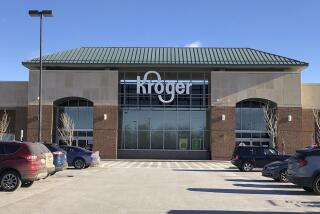U.S. stores say no to genetically engineered salmon. Someone has to.
- Share via
The nation’s two largest conventional grocery chains, Kroger and Safeway, have announced that they will not sell genetically engineered salmon. They join several other chains, including Target, Whole Foods (of course) and Trader Joe’s. Now let’s hope the holdouts, such as Costco, do the same.
The Food and Drug Administration has not yet decided whether to approve the salmon, with DNA retooled so that the fish grow twice as fast as conventional salmon. But the agency already has decided that the fish are safe to eat and are very unlikely to pose an environmental threat if they’re grown, as planned, in land-locked tanks.
The FDA’s final decision on the fish has been expected for a long time, and there is speculation that the agency has been holding off mainly because it knows that the public is inclined to look suspiciously on the new product.
The fish would be raised in the mountains of Panama nowhere near the ocean, and they would be rendered sterile and all of them female, to avoid mating. However, the pens would be right next to a river, and the technology for producing sterile fish is not perfect -- it would fail in up to 5% of the animals.
Even this shaky picture relies on the salmon-farming operation being run with maximum care at all times, with no sloppiness, no shortcuts taken. That leads to additional questions of how the underfunded FDA is planning to inspect, continuously and scrupulously, to ensure that the fish farm is doing everything as promised?
PHOTOS: Seven foods, genetically engineered
The fear is that the genetically modified salmon could breed with wild salmon and out-compete them for resources. Supporters of the product say that is incredibly unlikely to happen, but the past has taught us -- as with the possibility of earthquakes and tidal waves big enough to compromise the Fukushima nuclear plant -- that nature has ways of throwing surprises at us, especially in an arena as untested as this one.
Another consideration, which the FDA doesn’t talk about, is the opening of a door. This one operation might sound good to the agency (though it sounds like a potential environmental problem to me), but it would be a very small operation. The fish from this one farm would be a blip on the fish-market scene. However, once the U.S. market has been opened to these fish, the business would grow, the proposals would go on and it’s practically a given that not all of the subsequent operations would be carefully designed and run.
Consumer groups have taken matters into their own hands by appealing to food markets not to carry the fish, and they’re obviously having some notable successes.
The other markets should fall in line; they don’t need these salmon in their fish departments in order to succeed, and, in fact, they stand a good chance of turning off consumers who worry about making over the DNA of an animal that, for all the fish farms, is essentially a wild creature.
ALSO:
The truth about the great American science shortfall
Water conservation’s other benefit: It’s a power saver
About 3.5 hours of homework a day for high schoolers? That’s too much.
More to Read
A cure for the common opinion
Get thought-provoking perspectives with our weekly newsletter.
You may occasionally receive promotional content from the Los Angeles Times.







